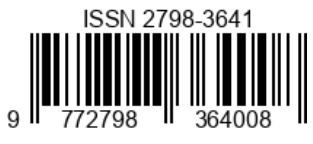SISTEM PAKAR DIAGNOSIS PENYAKIT PADA ANAK MENGGUNAKAN METODE CERTAINTY FACTOR
Keywords:
Certainty Factor, Diagnosis, Penyakit Anak, Sistem PakarAbstract
Anak yang sehat adalah anak dengan pertumbuhan yang optimal. Peran orang tua sangat penting dalam memastikan hal ini, namun sering kali penanganan yang terlambat menyebabkan anak jatuh sakit. Kendala seperti jarak ke fasilitas kesehatan, kesibukan, atau keterbatasan biaya sering menjadi penghambat untuk melakukan pemeriksaan dini. Untuk mengatasi masalah tersebut, pemanfaatan teknologi menjadi solusi yang efektif.
Salah satunya adalah sistem pakar berbasis web yang dapat diakses kapan saja dan di mana saja dengan dukungan internet. Sistem ini dirancang untuk membantu mendiagnosis penyakit pada anak dengan menggunakan metode Certainty Factor (CF), yang memungkinkan sistem melakukan diagnosis seperti seorang pakar atau dokter dengan mencocokkan data gejala dengan pengetahuan pakar.
Hasil pengujian menunjukkan bahwa sistem berjalan dengan baik tanpa adanya kesalahan (error) pada uji black box. Selain itu, pengujian dengan confusion matrix menunjukkan tingkat akurasi diagnosis sebesar 96%, dan hasil akhir User Acceptance Testing (UAT) menunjukkan tanggapan yang sangat baik, dengan rata-rata nilai Learnability 92,67%, Efficiency 93,7%, Memorability 93,7%, Errors 95,8%, dan Satisfaction 91,63%, menghasilkan skor akhir UAT sebesar 93,5%.
References
H. Sastypratiwi and R. D. Nyoto, “Analisis data artikel sistem pakar menggunakan metode systematic review,” JEPIN (Jurnal Edukasi dan Penelitian Informatika), vol. 6, no. 2, pp. 250–257, 2020.
K. Kevin, “Diagnosa Penyakit Jantung Menggunakan Metode Certainty Factor,” Jurnal Informatika dan Rekayasa Perangkat Lunak, vol. 3, no. 1, pp. 93–106, 2022.
D. Maulina, “Metode Certainty Factor Dalam Penerapan Sistem Pakar Diagnosa Penyakit Anak,” Journal of Information System Management (JOISM), vol. 2, no. 1, pp. 23–32, 2020.
B. Hendrik, “Penggunaan Metode Systematic Literatur Review Untuk Menganalisis Artikel Sistem Pakar Metode Forward Chaining,” Journal of Information System and Education Development, vol. 1, no. 2, pp. 1–5, 2023.
E. L. P. Zendrato, R. Fadillah, and R. J. Sidiq, “Tinjauan Literatur Sistematik pada Sistem Pakar untuk Diagnosa Penyakit Manusia,” AI dan SPK: Jurnal Artificial Intelligent dan Sistem Penunjang Keputusan, vol. 1, no. 1, pp. 1–8, 2023.
A. Sinha and P. Das, “Agile methodology vs. traditional waterfall SDLC: A case study on quality assurance process in software industry,” in 2021 5th International Conference on Electronics, Materials Engineering & Nano-Technology (IEMENTech), IEEE, 2021, pp. 1–4.
T. Thesing, C. Feldmann, and M. Burchardt, “Agile versus waterfall project management: decision model for selecting the appropriate approach to a project,” Procedia Computer Science, vol. 181, pp. 746–756, 2021.
V. A. Kurniyanti and D. Murdiani, “Perbandingan Model Waterfall Dengan Prototype Pada Pengembangan System Informasi Berbasis Website,” Jurnal Syntax Fusion, vol. 2, no. 08, pp. 631–637, 2022.
B. J. M. Putra, A. Fuâ, and D. A. F. Yuniarti, “Analisa dan Rancangan Sistem Informasi Pariwisata Pacitan dengan UML dan ERD,” Information System for Educators And Professionals: Journal of Information System, vol. 7, no. 1, pp. 63–72, 2022.
S. Y. Ravi, R. Jindal, and S. Anand, “A Study on Comparison of UML and ER Diagram,” Int. Res. J. Eng. Technol, vol. 7, no. 5, pp. 7575–7580, 2020.
A. Arias-Duart, E. Mariotti, D. Garcia-Gasulla, and J. M. Alonso-Moral, “A confusion matrix for evaluating feature attribution methods,” in Proceedings of the IEEE/CVF Conference on Computer Vision and Pattern Recognition, 2023, pp. 3709–3714. Accessed: Dec. 06, 2024. [Online]. Available: https://openaccess.thecvf.com/content/CVPR2023W/XAI4CV/html/Arias-Duart_A_Confusion_Matrix_for_Evaluating_Feature_Attribution_Methods_CVPRW_2023_paper.html
M. Heydarian, T. E. Doyle, and R. Samavi, “MLCM: Multi-label confusion matrix,” IEEE Access, vol. 10, pp. 19083–19095, 2022.
I. R. Munthe, B. H. Rambe, R. Pane, D. Irmayani, and M. Nasution, “UML Modeling and Black Box Testing Methods in the School Payment Information System,” Jurnal Mantik, vol. 4, no. 3, pp. 1634–1640, 2020.
S. Supriyono, “Software testing with the approach of blackbox testing on the academic information system,” IJISTECH (International Journal of Information System and Technology), vol. 3, no. 2, pp. 227–233, 2020.
B. Priyatna, A. L. Hananto, and M. Nova, “Application of UAT (User Acceptance Test) Evaluation Model in Minggon E-Meeting Software Development,” Systematics, vol. 2, no. 3, pp. 110–117, 2020.
N. S. R. Pillai and R. R. Hemamalini, “Hybrid user acceptance test procedure to improve the software quality.,” Int. Arab J. Inf. Technol., vol. 19, no. 6, pp. 956–964, 2022.















